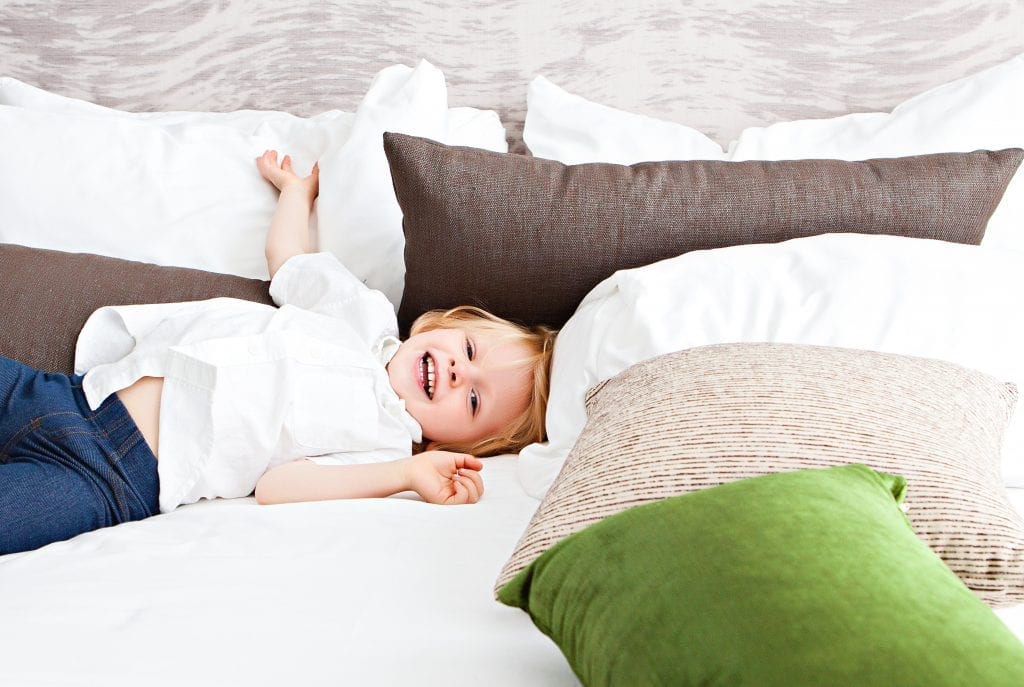Our overview of the pros and cons of popular types of mattress toppers.

As far as finding the best mattress topper, a better question to ask might be what’s the best mattress topper for you. The answer depends upon what’s most important to you–whether that’s cost, sustainability, comfort, or some other factor, like easing chronic pain–or some combination of these things.
Here’s an overview of some of the most common types of mattress toppers, their benefits and drawbacks, and what to look for in an environmentally friendly mattress topper.
Latex
The basics about latex mattress toppers
Natural latex is made from rubber sap harvested from trees. Unlike memory foam, body heat is not required for latex to mold to your body. Like a rubber band, latex stretches to contour and relieve pressure while simultaneously pushing back to provide support. There are several types of latex bedding products–we break them down here. In a nutshell, latex toppers can be made of anything from synthetic petrochemical-based materials to organic latex certified according to the Global Organic Latex Standard (GOLS).
Benefits of latex mattress toppers
Latex works in two ways to offer comfort and pain relief by contouring to relieve pressure while simultaneously pushing back to offer support. This material is ideal for people who feel hot while sleeping or who live in warmer climates. Latex also doesn’t require heat to activate. This means it can offer comfort and support with as little as two inches of thickness. Depending on the type of product, there is little to no off-gassing from latex mattress toppers. Off-gassing is the release into the air of VOCs (Volatile Organic Compounds). Synthetic latex toppers or toppers made from both latex and other materials are more likely to have off-gassing occur. However, 100% natural or organic latex mattress toppers don’t produce off-gassing. Be sure to check what your latex topper is made of before buying.
Downsides of latex mattress toppers
Because of the production process, including ingredient sourcing, of natural and organic latex, these mattress toppers last longer and perform much better than foam toppers. This means that latex mattress toppers are often more expensive than cheaper foam toppers made from petrochemicals. The natural elasticity of latex produces a “bouncy” feeling that may not feel comfortable for everyone. While reputable latex manufacturers wash their latex during processing to remove residual proteins that may cause allergic reactions, if you have a latex allergy, talk to your doctor to be sure it’s safe for you to use a latex mattress topper.
What to look for in an eco-friendly latex mattress topper
Shop for latex toppers that are certified or have components made according to the Global Organic Latex Standard (GOLS). This certification sets environmental standards for every step of the latex production process. Organic and natural latex mattress toppers are also more eco-friendly than those made from synthetic latex. Look for products made with either 100% natural latex made without fillers or for GOLS-certified organic latex. Finally, look for latex toppers made from carbon-neutral latex. For example, Naturally Nestled works with the only certified carbon neutral latex maker in the world.
Memory Foam
The basics about memory foam mattress toppers
Developed in the 1960s by NASA to make airplane seats more comfortable, memory foam is a popular material used to make mattresses, pillows, and mattress toppers. Also known as viscoelastic foam, memory foam is a type of polyurethane foam that uses body heat to contour around your body when you lie on it, springing back to its original shape when you get up. There are three main types of memory foam. The first type is traditional, which molds to your body. Open-cell is a type of memory foam that allows for better heat transfer. Finally, gel memory foam combines viscoelastic foam with cooling gel, which helps absorb heat better.
Benefits of memory foam mattress toppers
Memory foam molds to your body and is denser than polyurethane foam. This can help relieve arthritis and joint pain. This material also can reduce motion caused by someone turning over or getting out of bed.
Downsides of memory foam mattress toppers
Because memory foam is heat-activated to contour to your body, many of these types of mattress toppers tend to feel hot. However, gel-infused memory foam toppers are designed to mitigate this effect. Memory foam is heavy, and the thicker the memory foam, the more pressure relief on joints. Therefore, buying a thicker topper can also mean moving a heavier product into your home. Memory foam tends to emit a strong odor from “off-gassing” VOCs. While not dangerous in the quantities emitted by a mattress topper, this is still no fun if you’re sensitive to strong chemical odors. However, the odors dissipate after airing the topper out over a few days. Finally, all types of memory foam are made from petrochemicals, which means they are not sustainable products.
What to look for in an eco-friendly memory foam mattress topper
Unfortunately, because memory foam is petrochemical-based and not made from sustainable resources, there are no real eco-friendly options for memory foam toppers.
Polyurethane Foam
The basics about polyurethane foam mattress toppers
Also known as polyfoam, poly, or PU, polyurethane foam is similar to memory foam, without the added chemicals that allow it to mold and contour to the shape of your body. Look for an indication of the density of a poly topper when shopping for firmness or softness. Polyurethane foam density of at least 1.8 pounds/cubic foot offers the most comfort but is harder to find and more costly. Convoluted polyfoam, also known as egg crate foam, is a common type of mattress topper. Egg crate foam is simply polyurethane foam cut to shape it with ridges that resemble the inside of an egg carton, which is designed to ease pain points while sleeping. Look for polyfoam toppers that are certified by CertiPUR-US®, which ensures they are made without certain potentially harmful or irritating components and have low-VOC emissions.
Benefits of polyurethane foam mattress toppers
The biggest benefit of polyfoam toppers is that they’re cheap and easy to find at a wide variety of online and brick and mortar retailers. As with other types of mattress toppers, not all polyfoam toppers are alike. They come in multiple types of thickness and firmness that dictate the level of comfort and support offered. Finally, as with latex, polyfoam is cooler than either memory foam or featherdown toppers.
Downsides of polyurethane foam mattress toppers
The price point advantage of polyfoam decreases as a benefit because poly toppers don’t last as long as other types. They’re generally not as supportive as memory foam or latex toppers. Over time, polyfoam toppers can leave an indentation where you sleep. From an eco-perspective, polyfoam toppers are made from petrochemicals and tend to off-gas VOCs at first. While not harmful in the amounts emitted by a topper, this can be inconvenient and irritating to people who are sensitive to strong odors. Last but definitely not least, polyurethane foam mattress toppers are not sustainable products because they are made from petrochemicals.
What to look for in an eco-friendly polyurethane foam mattress topper
Unfortunately, because polyfoam is petrochemical-based and not made from sustainable resources, there are no real eco-friendly options for memory foam toppers.

Feather Down and Down Alternative
The basics about down mattress toppers
Down mattress toppers, also known as “down featherbeds,” are typically made using a combination of goose feathers and down. Down is made from the finer, fluffier white feathers found under the outer layer of goose feathers. Typically, down toppers are several inches thick and are often used as a luxuriously soft add-on to a mattress. There are also down alternatives that mimic the feel of down but are made from synthetic fibers. Look for toppers made with “baffle box” construction. This is a type of sewing method that helps keep the feathers and down in place to prevent shifting around within the topper.
Benefits of down mattress toppers
Down is widely used to keep people warm in products including mattress toppers, comforters, sleeping bags, and jackets. Down toppers add some additional comfort to the top of a mattress, but their biggest benefit is warmth.
Downsides of down mattress toppers
The biggest benefit to down toppers is also its biggest drawback. If you live in a warmer climate or tend to feel hot while sleeping, down toppers may not be the best option. People in colder climates can use these toppers during winter months for extra cozy warmth. Down toppers also tend to be more costly and offer little to no support or pressure relief. Finally, people with allergies to feathers should look for hypoallergenic featherdown options, or down alternatives.
What to look for in an eco-friendly down mattress topper
Look for toppers made from ethical goose down, also known as “green down” or “responsible down.” Currently, no single standard exists for what constitutes ethical down. Look for companies that guarantee cruelty-free components in their products or that carry a Responsible Down Standard certification label. For example, down can be harvested from nests without harming animals, or from animals that are treated humanely throughout the process.
Knowledge is power
We hope you find our guide to the types of mattress toppers useful. By knowing the different types of available materials and their benefits and drawbacks, you can find the best mattress topper to suit your personal needs.

